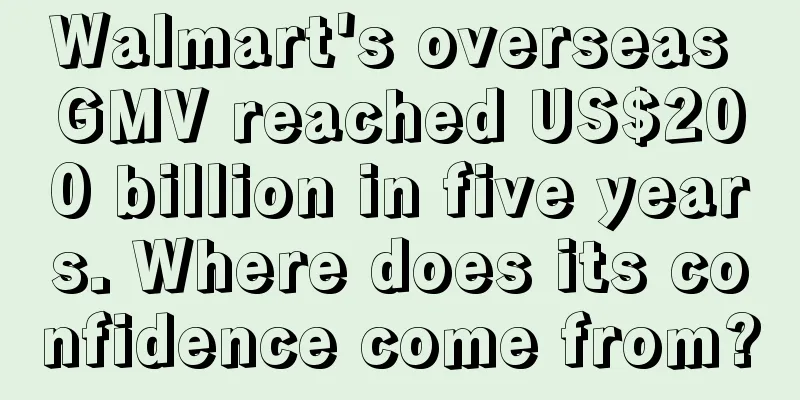Walmart's overseas GMV reached US$200 billion in five years. Where does its confidence come from?

|
It is learned that on June 2, Walmart International CEO Judith McKenna said at the annual shareholders' meeting that despite the continued instability of the global economy, Walmart still expects to double its total merchandise sales in foreign markets to US$200 billion within five years.
McKenna first announced Walmart's goal of doubling its overseas gross merchandise volume in April and has stuck with it even after the International Monetary Fund cut its global economic growth forecasts for 2023 and 2024, citing ongoing inflation concerns as a benefit.
Gross merchandise volume (GMV) measures the total value of all goods sold through a platform or marketplace, Walmart's businesses outside the United States, including the Cashi digital payment app platform in Mexico and the Flipkart marketplace in India.
According to Reuters, Walmart's international business had a total GMV of $120 billion five years ago, but after divesting its businesses in the UK, Brazil, Argentina and Japan, that figure fell to $100 billion in the fiscal year ending January 31, 2023.
Walmart's business model has changed over the past few years, with a greater focus on omnichannel.
McKenna said Walmart's growth will mainly come from implementing its omnichannel strategy globally, further expanding its market share in its existing 19 foreign markets and building an "ecosystem" of complementary businesses similar to the one in Mexico.
In addition to selling everyday items through its physical stores in Mexico, Walmart also offers financial services through its Cashi app, telecommunications services through BAIT, and now healthcare services in the country. Walmart’s omnichannel expansion efforts have led to a significant increase in its profits.
In the Indian e-commerce market, Flipkart, which is held by Walmart, far exceeds Amazon in market share. Flipkart has a 48% market share, almost twice that of Amazon's 26%. Flipkart's total sales in India in 2021 were $23 billion, while Amazon's were $18 billion to $20 billion.
Walmart has also surpassed Amazon in terms of share of the overall U.S. grocery market. Walmart’s share of the overall food and beverage market is about seven times larger than Amazon’s, according to PYMNTS.
As more of household budgets go to food, Walmart and other retailers are rethinking how they price apparel, home furnishings and other discretionary products or offering more discounts. For the upcoming back-to-school season, Walmart plans to offer lower prices on items such as notebooks or pens or pencils, and will offer more quantity and alternatives. Editor✎ Ashley/ Disclaimer: This article is copyrighted and may not be reproduced without permission. |
<<: Luxury spending in the U.S. slows, to rise slightly by 6.7% in 2023
>>: Shein and Temu are popular in the United States, but eBay still holds the position
Recommend
What is US Trademark Registration? US Trademark Registration Review
The trademark registration in the United States ad...
What is E2open? E2open Review
E2open was founded in 2000 and is headquartered in...
What is Hong Kong Company Audit? Hong Kong Company Audit Review
Hong Kong company audit is also called Hong Kong c...
What is Woobox? Woobox Review
Woobox is a platform for marketing campaigns. Crea...
What is Fuyou Payment? Fuyou Payment Review
Fuyou Payment is a service provider focusing on va...
Wanlihui has officially joined Walmart's global e-commerce platform, ensuring that sellers on the US site can receive and pay without any worries!
In the fiercely competitive global e-commerce batt...
Is it a scam? Everyone is doing the same thing and playing the same game, so why is it that my ad is not getting any exposure despite spending so much money?
Anonymous user My C position Category: Outdoor too...
US consumer confidence rises to 41% in Q3 2024
It is learned that McKinsey's ConsumerWise tea...
Nothing else, this Double 12, N kinds of discounts, 1 to support you - EU Cross-border Circle
"Double Eleven has already passed . Are the D...
Come and see, Amazon's flash sale policy has changed!!!
Recently, many seller friends have reported that t...
How to Reactivate Sales and Ranking of Old Amazon Products
If new products are the hope of the store and the ...
What is RetailMeNot? RetailMeNot Review
RetailMeNot is an enterprise service company that ...
The United States is reviewing Chinese companies listed in the United States! Are Alibaba and JD facing the risk of delisting?
It is learned that according to Reuters, starting ...
Walmart joins e-commerce layoffs, cutting hundreds of warehouse employees
According to CNBC, on March 23, a Walmart spokespe...
What is Outfy? Outfy Review
Outfy is a social media promotion tool. Outfy help...









